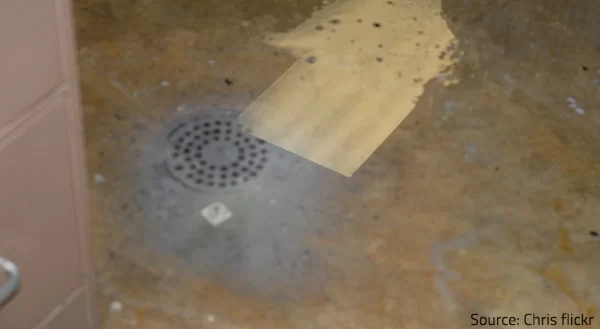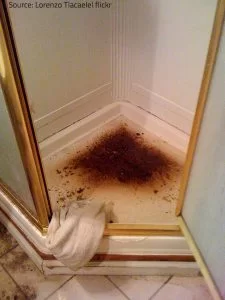A sewage backup is one of the most troublesome and foul incidents that can occur in a home – it can cause extensive property damage and severe health problems and, on top of that, it is extremely difficult and unpleasant to deal with. Cleaning up sewer backup requires a lot of time and effort, as well as specialized disinfecting products and purification techniques. Raw sewage cleanup, in particular, is especially laborious and risky as it not only causes a lot of hassle and inconveniences, but also presents a variety of health hazards (sewage spills contain contaminants that can cause serious diseases) and sanitation issues. Professional help is your best option in such situations, but you can do a few things to limit the extent of the damage before the experts arrive (or even deal with the problem yourself if the damage is not too severe).

What to Do After Sewage Backup
There are certain important precautionary measures to take after a sewage backup in order to prevent the damage from spreading:
- Keep children and pets away from the affected area;
- Put on appropriate protective equipment – rubber gloves, rubber boots, impervious coveralls, protective eyewear, and a facemask;
- Switch off the electrical power to your home (only if the distribution panel is safely above water). Wear rubber gloves and use a dry wooden stick to shut off the main switch;
- Turn off any running water and don’t use the water supply system in your home (it may even be a good idea to turn off the water supply to the building);
- Open doors and windows to allow fresh air inside (do not use the central air conditioning system to ventilate your home as sewage-contaminated dust and water droplets can enter the HVAC system and contaminate it);
- Take any dry, un-contaminated items away from the affected area;
- Add small amounts of chlorine bleach to standing water to ensure some disinfection;
- Notify your insurance company that there has been a sewage spill in your home;
- Contact your municipal authority or sewage department (if your home is connected to a public sewer) or your local health department (if your home is connected to a private septic system) and ask for advice;
- Call a professional water damage restoration company. The quick and efficient intervention of the experienced technicians will save you a lot of time and effort and will provide the most appropriate, safest, and cost-effective solution to the problem. Besides, most sewage cleanup companies offer not only water extraction, but also quality repair works, odor removal, and content cleanup, so you will have all the aspects of the restoration process taken care of when using professional sewage cleanup services.
Good to remember:
- Take pictures of the sewage spill and the water-damaged items and structural materials before removing them or having anything cleaned up (the photographs will serve as proof for your insurance claim). Keep all the receipts for materials and replacements, as well as for the repair and cleaning works performed in your home;
- Do not use harsh chemicals to unclog the draining system as they can cause severe damage to the pipes and sewer lines. Opt for treatment methods that use enzymes instead of chemicals or call a plumber to fix the source of the problem;
- Take appropriate measures to prevent cross-contamination (keep the doors between the contaminated area and the other rooms in your home closed, do not use the central air conditioning system until the problem has been solved, keep air pressure in the contaminated area lower than in the rest of the building, etc.) to ensure that sewage contaminated soil won’t be tracked into unaffected areas of your property and airborne sewage-contaminated dust (or mold spores) won’t be blown to other spaces.
How to Clean Up Sewage Backup
Sewage cleanup is better left to the professionals, but if the contaminated area is small and the HVAC system has not been contaminated, you can try to handle the task yourself. You’re recommended to:
- Wear personal protection gear, as already mentioned above. Make sure you don’t touch sewage material or sewage-contaminated items with bare hands, as direct contact with the skin can cause a serious infection;
- Remove any excessive water with the help of a pump (if there is a lot of water) or wet-dry vacuum that has an appropriate filtration device (if the spill is small). If you need to use a pump, check with the local authorities on where to drain the contaminated water;
- Shovel any solids into strong plastic bags and dispose of them immediately;
- Use paper towels and rags to soak up any remaining water;
- Remove any sewage-contaminated items and materials – rugs, curtains, upholstered furniture, household appliances, personal items, etc. – and store them in a sheltered area with a concrete or tiled floor that can be easily sanitized afterward. All contaminated content will be evaluated when the plumbing problem has been taken care of and salvageable items will be properly cleaned and restored;
- Remove any saturated carpeting, baseboards, wall paneling, insulation, flooring, etc. and take them to appropriate disposal sites;
- Hose down the area with clean water and wash all affected surfaces with a household detergent solution to remove any remaining sewage contamination and dirt;
- Wash all contaminated surfaces with a solution of chlorine bleach (or other bactericidal disinfectant) and cold water, mixed with a small amount of mild, non-ammonia dishwashing detergent (be careful not to mix chlorine bleach with ammonia, as they produce toxic fumes). Wait for about 15-20 minutes for the disinfectant to take effect and rinse thoroughly with clean water;
- Take extra care when cleaning the floors – scrub them well with a brush dipped in a solution of 3/4 cup bleach to 1-gallon water, change the clean water several times when rinsing the floors, and rinse the mop under running water every time you change the water;
- Dry the area as quickly as possible – open the windows (if the weather is dry and sunny), use portable fans to stir the air and create negative air pressure in the affected room, or run dehumidifiers (if it’s cold or wet outside) to dry out the wet area within 24-48 hours after the disaster in order to reduce the risk of mold growth;
- Address the contaminated content:
- Discard any consumable goods and porous materials (carpeting, curtains, upholstered furniture, mattresses, stuffed animals, books, and other paper goods, etc.) that have been in direct contact with the contaminated water;
- Have contaminated items of high sentimental or monetary value inspected by experienced restoration professionals. The experts will have the advanced equipment, specialized cleaning products, and technical know-how to sanitize and restore your salvageable valuables;
- Have slightly affected carpets professionally cleaned;
- Wash area rugs that have been in minor contact with sewage and dry them well before putting them back to use;
- Scrub slightly affected furniture pieces and appliances with antibacterial soap, rinse them well, and let them air dry;
- Wash all items that have been in contact with contaminated water with antibacterial cleaning products and dry them well;
- Add one cup of chlorine bleach to the water when washing contaminated clothes and linen;
- Place all items that have been in the affected area outside to air out, even if they have not been in contact with the sewage.
- Inspect your property for mold and take efficient precautionary measures to prevent mold growth. Have in mind that the increased levels of indoor moisture in the event of a sewage backup can cause mold growth throughout your home, even on surfaces that are not directly wet from the sewage spill. If you find any visible mold patches, use EPA approved sprays to kill the spores, disinfect all adjacent surfaces, and apply a sealant (when the area is completely dry) for added protection against mold growth in the future. Call mold mitigation specialists if the mold damage is too extensive.
Good to remember: The longer the contaminated waters remain in your home or on your items, the greater the chance of spreading disease and causing a mold problem. You need to take quick and efficient measures in order to prevent greater damage and more serious troubles. Using professional sewage cleanup services is your best bet as the experts will respond to your situation in the quickest, safest, and most appropriate manner possible. The pros will use specialized cleaning products, advanced equipment, and proven techniques to remove water from your home and restore it to a safe and good condition. Their quality services include:
- Removing sewage water and solid waste in a safe and appropriate manner;
- Removing contaminated content;
- Cleaning and sanitizing the area;
- Using professional grade air movers to ventilate and dry the area;
- Performing any necessary repair and restoration works;
- Restoring salvageable content to its original good condition;
- Performing mold mitigation services (if necessary) and/or taking efficient measures to prevent mold growth.
Proper sewage cleaning will ensure your peace of mind and allow you to get your life back on track soon after the disaster.
Once the problem has been solved, however, make sure you take the necessary precautions to reduce the chance of sewage backup in the future.
How to Prevent Sewage Backup
- Regularly inspect the pipes and valves on your property and keep them in good repair;
- Do not allow large amounts of harsh chemicals into the sewer system;
- Avoid disposing of grease down the kitchen drain as it can harden within the plumbing and collect debris to create a clog;
- Don’t flush napkins, tissues, diapers, and other waste down the toilet;
- Don’t plant trees or large shrubs directly above or near sewer lines as the roots can grow too large and break the pipes.
These simple measures will help you avoid sewage problems in the first place and will save you a lot of time, money, and nerves. However, if a disaster happens despite your best efforts, make sure you identify and fix the problem that caused the sewage backup and call reliable water damage restoration professionals to handle the sewage backup cleanup and ensure the excellent condition of your property.

